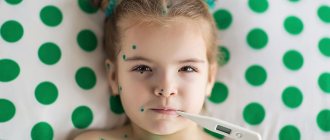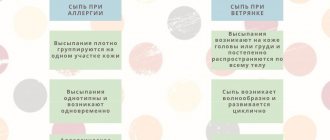December 14, 2020
The source of infection is a person with chickenpox. The incubation period (time from infection to the onset of symptoms) is 10-21 days. The sick person is contagious from the end of the incubation period until 5 days have passed from the appearance of the last fresh element of the rash.
The disease is transmitted by airborne droplets and contact. Can also pass from the pregnant woman to the fetus through the placenta.
Chicken pox is widespread. Children suffer from it more often; in them it is benign. Adults experience the disease more severely and are more likely to experience complications (myocarditis, encephalitis, sepsis).
There are mild, moderate, severe, atypical and asymptomatic forms of chickenpox. Main manifestations: polymorphic rash (macula, papule, vesicle) on the skin and mucous membranes, fever and signs of general intoxication. The rash usually starts on the face and scalp, then spreads to the entire body. It looks like a reddish spot, then transforms into a tubercle, vesicle and crust. Itching is characteristic, so scratching the skin may cause a secondary infection.
The disease is diagnosed by clinical and epidemiological signs, laboratory tests (PCR, ELISA, determination of IgM and IgG antibodies).
Mild forms can be treated at home. Seriously ill patients and those who cannot be isolated (dormitories, boarding schools, living in unfavorable living conditions) are hospitalized.
Why is quarantine declared for chickenpox?
Chickenpox is an extremely contagious disease. It is transmitted aerogenically (airborne), which makes it almost impossible to track the spread of the disease. In this regard, each case or suspicion of chickenpox is recorded and registered in accordance with the sanitary and epidemiological rules SP 3.1.3525-18 “On the prevention of chickenpox and herpes zoster”.
Attention
Quarantine for chickenpox is declared to control the outbreak of the disease. Anyone who has been in contact with the patient, unless they have been vaccinated or have had chickenpox before, should self-isolate at home or in a hospital setting if symptoms are severe.
Main symptoms of the disease
Chickenpox is caused by a virus called varicella-zoster. This virus is also the cause of herpes zoster.
The main symptom of chickenpox is a skin rash . In the normal course of the disease, one or two days after the onset of a cold and cough, a characteristic red rash appears on the skin, which is accompanied by severe itching.
The rash first appears on the face, chest and back, then quickly spreads throughout the body. After a few days, the spots on the body will turn into blisters, when they become crusty, the patient will no longer be contagious to others.
From the moment of infection until the first symptoms appear, it can take from ten to twenty-one days. Body temperature with chickenpox can rise to 40° C and last up to five days.
How long is the incubation period for children with chickenpox?
Most often, the virus is contracted by children aged 3 to 7 years. The disease proceeds without complications. The symptoms are:
- increased temperature (above 38 degrees for several days);
- apathy;
- loss of appetite;
- rash.
In some cases, chickenpox is asymptomatic or only a rash appears. The incubation period lasts from 10 to 21 days. The child is contagious for another 5 days after the last rash appears.
Doctors' opinion
Doctors are of the opinion that it is best to get chickenpox in childhood/adolescence, since the disease is quite mild and leaves no complications. With adults things are completely different.
Stable immunity to the herpes virus is usually developed in childhood, after suffering from the disease.
Stopping the spread of the virus means that the number of adults without immunity is growing every day. For an adult, ordinary chickenpox can cause serious health consequences that can lead to disability or death.
According to statistics, the most common complications are the following pathologies:
- Systemic diseases, including sepsis.
- Encephalitis, meningitis.
- Lymphadenitis.
- Purulent ulcers and much more.
Quarantine period for chickenpox
The maximum and minimum quarantine periods for chickenpox are identical in all institutions. The specific duration is indicated in the order, but is usually 21 days, which is issued by the local executive authority based on a medical report.
| Duration of quarantine | Who is going to quarantine? | Who cannot visit the institution | |
| Kindergarten | up to 21 days from the moment the last infected person was identified | all the children from the group | sick children; children with whom contact was excluded on the day the quarantine was announced |
| School | from 10 to 21 days | all the children in the class | sick students; students who have not had chickenpox or who have not completed the full course of vaccination, who were in contact with a patient 2 days before the onset of symptoms and later |
| Workplace | from 10 to 21 days | sick employees; employees who had contact with an infected person 2 days before the onset of symptoms and later, if they have not previously had chickenpox or have not been vaccinated |
Who should not visit quarantine facilities?
If a chickenpox quarantine has been declared in any institution, the following persons are not recommended to visit such institutions:
- Pregnant women.
- To old people.
- Children under 1 year.
If for some reason it is impossible to bypass this institution, be sure to wear a medical mask. If we are talking about a maternity hospital, pregnant women who have at least two weeks left before the expected date of birth are offered to go home during quarantine.
During quarantine in the maternity hospital, visiting by unauthorized persons is prohibited.
How is quarantine due to chickenpox considered?
Quarantine for chickenpox can be extended several times. It all depends on the number of infected people and the period of detection of new patients. After each case of detection of a sick person in accordance with the order, the period with quarantine measures is extended to reach 21 days with a new patient.
For your information
Often in kindergartens, quarantine ends after all the pupils in the group have had chickenpox.
Throughout the entire period, the condition of children is monitored to quickly identify new cases of the disease.
How many days can sick leave last?
Due to the rapid spread of infection, the patient is subject to mandatory isolation from society . That is why problems with sick leave due to chickenpox usually do not arise. Sick leave is required at least for the period of greatest danger of the disease - until the last rash appears.
If a child is sick, he or she needs special support and care, especially due to the difficulties of isolation. In this case, the parent has the right to receive a child care certificate.
Children are provided with sick leave for a period of five to ten days. This depends on the individual characteristics of the disease and the possibility of complications.
In most cases, the sick leave period ends on the fifth day after the last rash. It is believed that if no new papules appear on the body, the body has coped with the infection.
The situation changes somewhat if an adult gets chickenpox. In childhood, the disease is much easier to tolerate than in adults. A sick leave certificate for an adult is usually issued for a period of ten to thirty days. Complications are very likely to occur; in this case, sick leave can be extended for up to a year.
Quarantine conditions in kindergarten
If there are symptoms of chickenpox, parents and their young son or daughter should consult their doctor. If the observation is carried out in a public clinic, then the procedure is as follows:
- The doctor identifies the disease or suspicion of it.
- Within 2 hours from the moment a child is identified with chickenpox, a medical worker is obliged to notify the executive authorities of the discovery of a source of disease.
- The doctor is obliged to report information about the child with chickenpox to the kindergarten within 2-12 hours.
- If there are at least 2 infected people in a group, quarantine is declared.
- The kindergarten is obliged to notify all parents about the measures taken and the opportunity to refuse to attend the kindergarten or to transfer to another group.
IMPORTANT
If the diagnosis was made by a doctor in a private clinic, he is not obliged to report this to the kindergarten. However, it still reports to local executive authorities to register the case. Next, the preschool educational institution receives a call from the local administration. Parents can also report illness to the teacher themselves.
Children who have been diagnosed with the disease cannot attend kindergarten; chickenpox treatment is carried out at home. The remaining pupils can continue to attend kindergarten at the request of their parents.
To ensure the safety of other children, the following preventive measures are taken:
- the group does not go out for walks at the same time as other groups;
- a separate entrance is used so as not to interfere with other kindergarteners;
- Wet cleaning of the room and toys is carried out 2 times a day;
- the room is quartzed;
- 2 times a day, a medical worker conducts a visual examination of kindergarteners to identify those infected;
- Any events (going to the pool, museum, zoo, etc.) are canceled.
If a child was not in the group on the day chickenpox was announced, he may be transferred to another group as potentially non-infectious.
How to act in an epidemic outbreak: sanitary standards
SanPiN for chickenpox recommends following the standards for preventing the spread of the virus:
- ventilate the premises through the air before and after visiting children for half an hour;
- increase the break between classes to 10 minutes;
- carry out wet cleaning of premises every day;
- maintain air humidity at 60-80%;
- Disinfect the room with a quartz lamp 2 times a day;
- perform antiseptic treatment of toys;
- promptly isolate sick children.
Chickenpox is a highly contagious disease and all measures aimed at preventing it work poorly. Most parents deliberately send their children to the quarantine group, since chickenpox infection is most easily tolerated in childhood.
Post Views: 3,070
Tags: preschool educational institution, quarantine, kindergarten, SanPiN, school
How is the chickenpox quarantine at school?
The announcement of quarantine at school follows the same pattern as for kindergarten. A doctor informs about the registration of a case of chickenpox, after which an order must be issued from the local executive authority to comply with quarantine measures.
The first step is to identify students who may have become infected. This category includes schoolchildren who interacted with the sick person 2 days before the onset of symptoms or within 5 days after.
Children who have been in contact with the patient are sent to quarantine. In accordance with sanitary and epidemiological rules, only students over 7 years of age who have already had chickenpox or have completed a full course of vaccination are not subject to such separation.
Schoolchildren who are not quarantined due to chickenpox continue to go to school. However:
- all public events, including school trips, are cancelled;
- medical staff checks the condition of students every day from the class where the sick person was identified;
- Particular attention is paid to wet cleaning of the premises.
Also, if more than 5 patients with chickenpox are identified, a commission is sent to the school to monitor compliance with quarantine rules.
What certificates should I take and from whom?
If your baby had chickenpox, how many days you need to be at home, you knew and successfully defeated the disease, but were faced with a documentary type of trouble, it will be interesting to know that parents are issued a sick leave for chickenpox in children for 10 days. Sometimes this time is not enough to completely cope with the baby’s illness and there are two ways out of the situation. The doctor can send the parent to work, and leave the child in the care of other relatives, or the parent extends the sick leave for another 4 days. This is permitted by the laws of the country.
As for when to visit the kindergarten after chickenpox, parents should bring the baby for examination to a regional therapist in a children's clinic. After examining the skin, the doctor can issue a certificate that the child is completely healthy and can attend a child care facility. In most cases, such a certificate is issued five days after new blisters on the skin have completely stopped appearing.
Despite the fact that the forced holidays for the child and parent last more than three weeks, there are unpleasant symptoms and hassle, it is better for your child to get sick before the age of 10 years. If this does not happen, be sure to get vaccinated. Forced interruption at home will seem like a trifle to you, in comparison with the serious complications after chickenpox, which affect vital organs if an adult child is sick.
We recommend the popular Zen channel “https://zen.yandex.ru/build-experts.ru”, where you will find a lot of useful information for summer residents and gardeners.
Quarantine rules for chickenpox in adults
After an employer has received notice that one of its employees has chickenpox, it must:
- remove the employee from work or transfer to a position where the risk of infection of other employees is excluded;
- identify workers who have not had chickenpox before and have not completed the vaccination course;
- send employees who have been in contact with a sick colleague to isolation.
An order for quarantine at work is issued if there are more than 5 cases of chickenpox. Employees sent to home isolation in accordance with Art. 76 of the Labor Code do not receive wages, unless otherwise provided by local regulations or the company charter. However, if you have a certificate from an infectious disease specialist in accordance with Art. 6 Federal Law No. 255 “On Compulsory Social Insurance”, suspended employees receive temporary disability benefits.
Attention
Employees who have been in contact with a person with chickenpox may be transferred to remote work before quarantine is announced. Without an order, while on observation, they cannot count on benefits.
Drug treatment of chickenpox
Local therapy plays a special role in the treatment of rashes. It helps improve the healing of skin surfaces, preventing the appearance of scars, cicatrices and secondary infection of pimples.
It is advisable to treat skin lesions with any antiseptic agents. These are brilliant green, Tsindol, Baneotsin, Fukortsin. This group of drugs eliminates re-infection of elements, promotes their rapid drying and epithelization.
The most modern medicine is Calamine. It is applied topically and has a complex antiallergic and antiseptic effect.
Also prescribed for the treatment of the infectious process:
- Antipyretic drugs. Reduces temperature and improves well-being.
- Antiviral agents. They are used to destroy the main infectious agent.
- Antihistamines. Suppresses severe itching and prevents other signs of allergies. Used for oral and external use.
- Painkillers. Fight headaches and throat discomfort. Used in tablet form.
When localizing papular elements in the oral cavity, it is recommended to use:
- Boric acid 1% as an antiseptic.
- Kamistad, Kalgel and other painkillers.
- Sea buckthorn oil or Solcoseryl to reduce irritation and accelerate epithelization.
Sick leave during quarantine for chickenpox
A sick leave for chickenpox is issued by an infectious disease specialist or attending physician. If this sheet is available, in accordance with Federal Law No. 255, an adult will receive temporary disability benefits in cases where:
- he himself fell ill;
- he came into contact with an infected person at work, where quarantine has been declared;
- he is the parent of a child whose group has been quarantined.
IMPORTANT
A parent can receive a sick leave certificate even if his child is not sick and is not at risk (has been sick before or has completed a full course of vaccination).
Vaccination during quarantine
Parents of their children often wonder whether to get a vaccine if a quarantine has been declared in a preschool institution? Can I get other vaccinations during chickenpox quarantine? Competent experts say that to prevent chickenpox infection, immunization of a fragile organism is not contraindicated.
In case of contact with a sick person, emergency preventive vaccination with Varilrix can be carried out.
Regarding mantoux and other vaccinations, it is better to refrain from immunization until the end of quarantine in a preschool institution.










